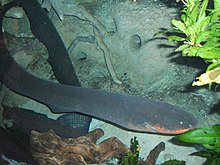Electricity is not a human invention, and may be observed in several forms in nature, a prominent manifestation of which is lightning. Many interactions familiar at the macroscopic level, such as touch, friction or chemical bonding, are due to interactions between electric fields on the atomic scale. The Earth's magnetic field is thought to arise from a natural dynamo of circulating currents in the planet's core.[69] Certain crystals, such as quartz, or even sugar, generate a potential difference across their faces when subjected to external pressure.[70] This phenomenon is known as piezoelectricity, from the Greek piezein (πιέζειν), meaning to press, and was discovered in 1880 by Pierre and Jacques Curie. The effect is reciprocal, and when a piezoelectric material is subjected to an electric field, a small change in physical dimensions take

place.[70]
Some organisms, such as sharks, are able to detect and respond to changes in electric fields, an ability known as electroreception,[71] while others, termed electrogenic, are able to generate voltages themselves to serve as a predatory or defensive weapon.[3] The order Gymnotiformes, of which the best known example is the electric eel, detect or stun their prey via high voltages generated from modified muscle cells called electrocytes.[3][4] All animals transmit information along their cell membranes with voltage pulses called action potentials, whose functions include communication by the nervous system between neurons and muscles.[72] An electric shock stimulates this system, and causes muscles to contract.[73] Action potentials are also responsible for coordinating activities in certain plants and mammals.[72]



0 comments:
Post a Comment